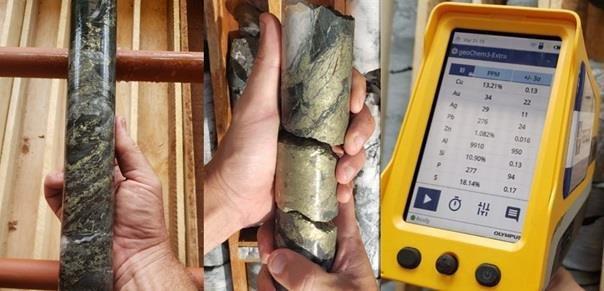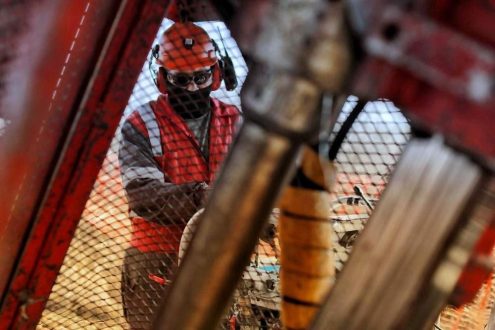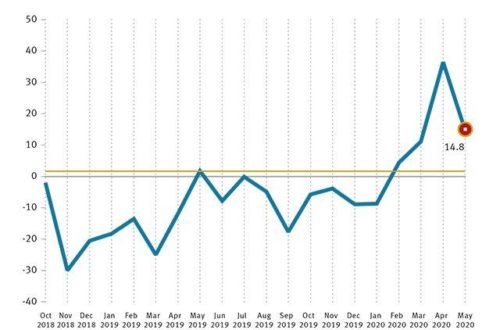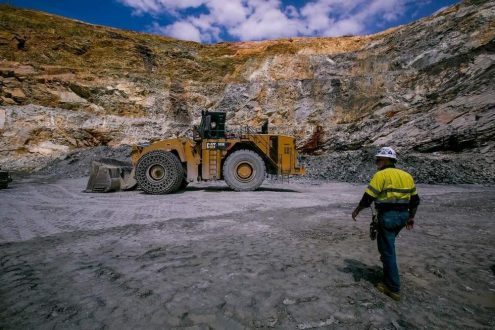
Meridian Mining Drills Strong Sulphide Mineralization At Its Cabaçal VMS Copper-Gold Project
Meridian announced the roll-out of its field program following the granting of a environmental permit for drilling in March, and mobilized two drill rigs and a geophysical team to commence a 10,000m diamond drilling program. One of the initial focus areas was in the southern sector of the deposit defined as the Southern Copper Zone (SCZ), where historical drilling suggests the presence of high grade NW-SE trending alteration pipe hosting copper-gold-silver mineralization.
Diamond drill holes CD-003 and CD-004, both targeting the SCZ, intercepted significant mineralization, as was illustrated by portable XRF readings of the cores. An impressive highlight returned a reading of 13.21% copper, 34g/t gold, 29g/t silver and 1.08% zinc (see picture above). The example provides a provisional point-source reading of mineralization within the higher-grade zone, with the grades being consistent with expectations from the historical drill result. According to management, such readings provide a useful confirmation of sulphide metal associations identified by eye. Actual assays from a lab are of course required to properly quantify the intercepts, and these are expected later in April.
All pictures are company material, unless stated otherwise.
All currencies are in US Dollars, unless stated otherwise.
Zooming in a bit further on the drill holes, CD-003 was targeted as an infill hole between historical hole JUSPD 596, which intersected 15m @ 5.2g/t Cu, 2.66g/t Au, and 9.54 g/t Ag, and adjacent holes to the south which intersected broad packages of mineralization.
CD-004 was set up to target a position projecting about 20m south of the limit of historical workings The hole was drilled from the location of the historical drill pad of JUSPD 596, and as part of a fan (a fan means a series of holes drilled from a common platform on different trajectories, with holes directed in this case to the NW and NE). CD-004 was drilled in the vicinity of historical drill hole JUSPD482, which intersected 13.4m @ 5.50% Cu, 1.31g/t Au, and 24.72g/t Ag. The two holes targeted positions about 85 m apart along the NW-SE trending mineralization corridor.
The geologists of Meridian identified a breccia to stringer sulphide zone of 11.4m length from 156.9m to 168.3m depth for hole CD-003, and this zone is expected to generate the higher-grade results after assaying. For hole CD-004 this is a likewise zone of 13.1m length from 151.3m to 164.4m depth. Both holes have a longer disseminated sulphide mineralization zone starting at 46 to 54.8m depth, continuing to depths of 168.3 and 164.4m respectively. According to CEO McArthur, this breccia to stringer zone is more commonly located at key stratigraphic contacts (in this case directly above the acid volcanic footwall (“TAC”) horizon). The disseminated sulphide has been historically defined as a series of broader stacked sheets, examples of which are illustrated in this cross section.
Earlier holes CD-001 and CD-002 were drilled in advance, with CD-001 targeting to simply twin JUSPD 596, and CD-002 targeting shallow high grade copper gold mineralization of the Eastern Copper Zone. Assays of these two holes are also expected later in April. The locations of the four drill holes can be seen on this map, which is also showing historic mine workings and examples of historic drilling, projected on a VTEM image in the background with blue representing more conductive zones, in order to provide context.
In the meantime, surface EM surveys have commenced to characterize the geophysical response associated with the Cabaçal Mine, together with borehole EM surveys. Electromagnetic surveys detect anomalies associated with sulphides – the more connected the sulphide assemblage, the stronger the response. Results of both surveys are expected later this month.
CEO McArthur is obviously pleased with the ongoing progress, as he stated:
“The two new holes confirms the full mine sequence stratigraphy in the Southern Copper Zone, with the sulphide rich basal layer intact. The mineralization style seen in sulphide-rich basal layer corresponds to the characteristics of the target corridor identified in the 1990 Mason and Kerr study, which interpreted the position as part of a major NW-SE trending alteration pipe of higher grade copper-gold-silver mineralization. Additional drilling geophysics will be undertaken to trace the extent of this position towards the historical workings and consider extensional projections to the south east. The wide package of disseminated mineralization is consistent with our expectations. The ongoing program will continue to test both the broad envelope on mineralization and more discrete high-grade trends in working towards a 43-101 resource update and development studies.”
The concept of a major alteration pipe of copper-gold-silver mineralization sounds interesting. I wondered why Mason and Kerr reached this interpretation, what kind of strike length we could be looking at, why McArthur thinks the mineralization is consistent with their thesis, and how McArthur thinks why and how he should try to verify the Mason/Kerr thesis. He stated that the Mason and Kerr study was undertaken in 1990 to identify targets requiring follow-up drilling. This particular corridor has been defined over a 100m strike length, but it’s southern extensions are poorly defined, with the map showing the drill density rapidly becoming wide-spaced with increasing distance from the historical workings. The drill program coupled with surface and down-hole geophysics will provide vectors to the areas of greater sulphide concentrations within the broader halo of disseminated and stringer mineralization.
The current drilling is part of a 60-70 hole drill program for 10,000m, of which 30 holes are twinning holes, in order to verify the 21.7Mt historic resource estimate. This 10,000m program is expected to be completed by the end of Q3, 2021, and management is targeting a maiden NI43-101 compliant resource estimate by Q4, 2021. In addition to this, management is also working on verification of a 600 hole historical data base from BP/Rio Tinto, in advance of the resource update.
Conclusion
The sulphide intersections and pXRF readings seem to indicate that Meridian Mining could have a pretty attractive project at the right time in the metal price cycle. As drilling and surveys are underway now, expect lots of news flow the coming months. It will be very interesting to see the assay results at the end of this month, combined with a nice set of sections and drill collar maps, and on top of this hopefully interesting EM survey results, to indicate the potential district scale opportunity targeted by management. So far things are looking very promising for Meridian Mining.
I hope you will find this article interesting and useful and will have further interest in my upcoming articles on mining. To never miss a thing, please subscribe to my free newsletter, in order to get an email notice of my new articles soon after they are published.
Disclaimer:
The author is not a registered investment advisor and has a long position in this stock. Meridian Mining is a sponsoring company. All facts are to be checked by the reader. For more information go to www.meridianmining.co and read the company’s profile and official documents on www.sedar.com, also for important risk disclosures. This article is provided for information purposes only and is not intended to be investment advice of any kind, and all readers are encouraged to do their own due diligence and talk to their own licensed investment advisors prior to making any investment decisions.
Swiss Resource Capital AG
Poststrasse 1
CH9100 Herisau
Telefon: +41 (71) 354-8501
Telefax: +41 (71) 560-4271
http://www.resource-capital.ch
CEO
Telefon: +41 (71) 3548501
E-Mail: js@resource-capital.ch
![]()



